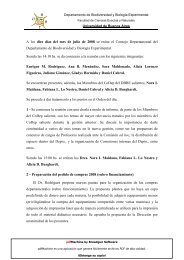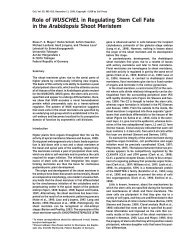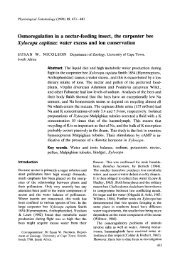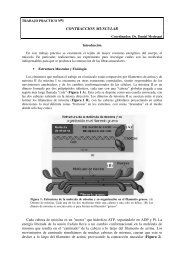The Aerobiology Pathway
The Aerobiology Pathway
The Aerobiology Pathway
You also want an ePaper? Increase the reach of your titles
YUMPU automatically turns print PDFs into web optimized ePapers that Google loves.
<strong>The</strong> airborne dust around combine harvesters contained up to 200 million fungus spores<br />
per m 3 air while drivers were exposed to up to 20 million spores per m 3 air. <strong>The</strong> workers<br />
affected had an immediate hypersensitivity reaction to the spores. It was suggested<br />
that drivers could be protected by cabs ventilated with filtered air (Darke et al., 1976),<br />
this is now standard practice. However, attention needs to be paid to the effectiveness of<br />
the air filters used in combine harvester cabs. Studies have shown that well fitted filters<br />
provide good protection against airborne spores, but aerosols can easily by-pass damaged<br />
or poorly maintained filters. Also, opening the cab door or window in a contaminated<br />
environment can negate the protective effect of a cab air filter within 3 minutes<br />
(Thorpe et al., 1997).<br />
<strong>The</strong> air in grain silos, sampled using a cascade sampler and an Andersen sampler<br />
while the grain was being unloaded, produced huge concentrations of bacteria, actinomycete<br />
spores and fungal spores. Many of these were viable and some were potentially<br />
pathogenic e.g. Aspergillus fumigatus (Pl. 10.16). It was recommended that workers<br />
should use efficient dust respirators inside silos when handling grain (Lacey, J., 1971a).<br />
5.2.5. Compost handling and locating refuse or composting facilities<br />
Different types of materials used for producing compost affect the type and numbers of<br />
spores released during the composting process, there can also be seasonal as well as daily<br />
changes in the number and types of spore released from composting sites. Domestic<br />
waste composts can produce high numbers of airborne bacteria (Lacey, J., et al., 1992).<br />
EU legislative targets to reduce landfill disposal of waste and encourage recycling has led<br />
to a large increase in the number of green waste composting sites. However, public concern<br />
about exposure to the potentially high numbers of spores released means that the<br />
location of composting sites requires careful consideration (Lacey J, 1997). <strong>The</strong> potential<br />
for exposure to airborne spores, including Aspergillus fumigatus, and hazards to respiratory<br />
health associated with waste composting have been reviewed by Swan et al.<br />
(2002). Refuse dumps and landfill sites pose a further risk of release of potential allergens<br />
and pathogens through dry release and rain-splashed aerosols.<br />
Mushroom compost is traditionally made from wetted straw and horse manure,<br />
which heats up during composting as many thermophilic actinomycetes grow. When<br />
moved into the growing sheds many more spores are emitted than at picking of the<br />
mushroom crop (Crook and Lacey, J., 1991).<br />
5.2.6. Respiratory infections<br />
In addition to allergic reactions or irritation, some airborne microbes (other than causal<br />
agents of illnesses such as colds, influenza and pneumonia) can cause respiratory system<br />
infection in humans (Campbell et al., 1996; Samson et al., 2001). An example, of a fungus<br />
capable of causing disease following inhalation is Aspergillus fumigatus, which normally<br />
grows on grain or compost. <strong>The</strong> fungus can grow saprophytically on mucus in the<br />
airways to cause bronchopulmonary aspergillosis, occasionally producing a ball of fungal<br />
growth or aspergilloma. Serious problems can occur in subjects that have suppressed<br />
THE AEROBIOLOGY PATHWAY 29




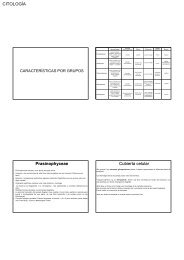


![Estructuras secretoras internas [4.64 MB]](https://img.yumpu.com/14294979/1/190x143/estructuras-secretoras-internas-464-mb.jpg?quality=85)
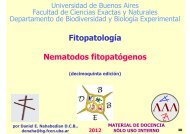
![anatomía y exomorfología [7.14 MB]](https://img.yumpu.com/12744163/1/190x143/anatomia-y-exomorfologia-714-mb.jpg?quality=85)
